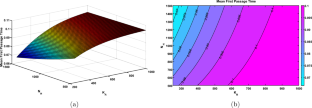The European Physical Journal Plus ( IF 3.4 ) Pub Date : 2024-04-09 , DOI: 10.1140/epjp/s13360-024-05108-z Suman Kumari , Partha Sarathi Mandal , Moitri Sen

|
The potential of zoonotic diseases to cross-species physical boundaries makes them a persistent threat to global public health. Of all the zoonoses, the bubonic plague serves as a historical and modern model. In this work, we investigate a bubonic plague stochastic model using a continuous-time Markov chain (CTMC) model to study the disease dynamics in rats and humans. Using a Galton–Watson multi-type (GWbp) branching process, we have derived an analytical expression for disease extinction probability at the beginning of the epidemic. There is a variation in disease extinction probability calculated via the branching process and numerical simulations, which is the consequence of the discrete assumption of an infected flea instead of being considered in terms of an infected rat in the numerical simulation. An analytical expression for the distribution of first passage time (FPT) to spillover is also obtained in this work using the probability generating function (PGF) technique, and it agrees well with the FPT distribution obtained numerically. This distribution is defective since infected fleas can die before infecting human. Furthermore, the effect of the initial rat population on the FPT of spillover is also shown, which suggest that as the initial rat population increases, the likelihood of spillover decreases, and it increases as the rat population decreases. Additionally, we have derived an expression for the mean and variance of the first passage time to spillover, and we incorporate the impact of various parameters on the mean first passage time of spillover. Lastly, we have performed numerical simulations to estimate the peak size of each infected class and the related time to attain peak infection. The peak of the infected flea, which is a disease carrier, is much higher as compared to that of rat and human. Also, there is a delay in attaining peak size for the human population, which is the consequence of the human population being a secondary host for fleas to survive.
中文翻译:

复杂流行病模型的首次通过时间和峰值大小概率分布
人畜共患疾病跨物种物理界限的潜力使其对全球公共卫生构成持续威胁。在所有人畜共患病中,黑死病是历史和现代的典范。在这项工作中,我们使用连续时间马尔可夫链 (CTMC) 模型研究黑死病随机模型,以研究大鼠和人类的疾病动态。使用高尔顿-沃森多型(GWbp)分支过程,我们推导了流行病初期疾病灭绝概率的解析表达式。通过分支过程和数值模拟计算出的疾病灭绝概率存在差异,这是离散假设受感染跳蚤而不是在数值模拟中考虑受感染老鼠的结果。本文还利用概率生成函数(PGF)技术得到了首次通过时间(FPT)到溢出的分布的解析表达式,它与数值计算得到的FPT分布非常吻合。这种分布是有缺陷的,因为受感染的跳蚤可能会在感染人类之前死亡。此外,还显示了初始老鼠数量对溢出 FPT 的影响,这表明随着初始老鼠数量的增加,溢出的可能性降低,并且随着老鼠数量的减少而增加。此外,我们还推导了溢出首次传代时间的均值和方差的表达式,并纳入了各种参数对溢出平均首次传代时间的影响。最后,我们进行了数值模拟来估计每个感染类别的峰值大小以及达到峰值感染的相关时间。作为疾病携带者的受感染跳蚤的峰值比大鼠和人类高得多。此外,人类数量达到峰值的时间也有所延迟,这是人类作为跳蚤生存的第二宿主的结果。



























 京公网安备 11010802027423号
京公网安备 11010802027423号